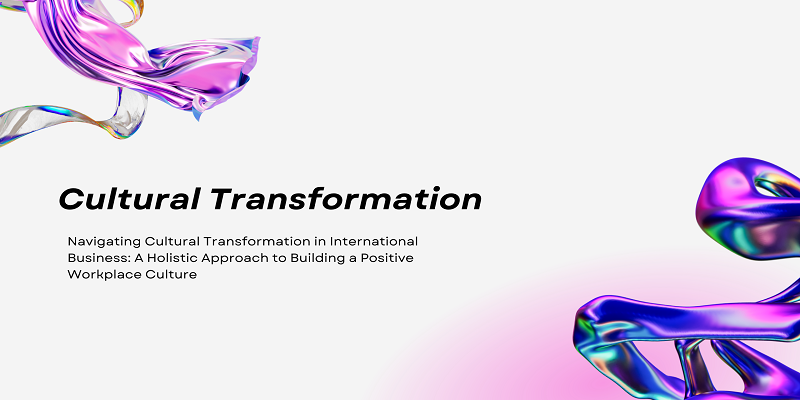Navigating Cultural Transformation in International Business: A Holistic Approach to Building a Positive Workplace Culture

In today’s fiercely competitive business landscape, fostering a positive workplace culture is not just a luxury; it’s a strategic necessity. Disgruntled employees can be detrimental to productivity, innovation, and overall business success. Achieving a cultural transformation in the workplace requires a deliberate strategy and execution, focusing on the beliefs and behaviors that shape the way things are done within an organization. In this comprehensive guide, we will explore the pathways of cultural transformation in international business, delving into key elements such as defining, directing, enabling, and motivating the transformation.
Pathways of Cultural Transformation:
1. Defining the Transformation:
The foundation of cultural transformation lies in defining the organization’s DNA—its business and brand blueprint, values, purpose, and employee value proposition. This serves as the control tower for all other pathways, providing a continuous guide for ongoing change. The clarity in defining transformational elements ensures a cohesive and consistent cultural shift.
2. Directing the Transformation:
Directing cultural transformation involves focusing on cultural levers that impact the organization as a whole. This holistic approach considers processes, governance, roles, systems, and tools, forming an operating model that substantiates the transformation. Organizations need to take a comprehensive view of these elements to qualify and make the cultural shift a tangible reality.
3. Enabling the Transformation:
The mind, as a crucial element in the human-centered transformation model, is where organizations identify and build the potential required for employees to flourish. Enabling the transformation involves creating an environment that nurtures learning, growth, and adaptability. This pathway ensures that employees possess the skills and mindset needed to thrive in the digital age.
4. Motivating the Transformation:
Motivating cultural transformation requires addressing the heart and soul of the organization. In the human-centered transformation model, the soul represents leadership authenticity and trust-building. Leaders play a pivotal role in embodying the transformation journey, fostering trust among employees to embrace and evangelize new ways of working.
Key Outcomes of Cultural Transformation:
1. Increased Productivity and Revenue at Lower Cost:
Organizations that align with cultural transformation potentialize collaboration, purpose, and unity of passion. This not only leads to higher employee satisfaction and engagement but also enhances retention. The resulting positive work environment contributes to increased productivity and profitability, simultaneously reducing costs.
2. Increased Innovation and Competitiveness:
An inclusive workplace culture that values diverse ideas and opinions fosters innovation. Cultural transformation encourages employees to feel comfortable proposing new ideas and taking calculated risks. This inclusive approach not only sparks creativity but also enhances an organization’s competitiveness in a rapidly evolving market.
3. Providing Feedback and Ratings:
A crucial aspect of maintaining a positive culture is establishing effective communication channels. Implementing a 360-degree feedback system allows for comprehensive evaluations, where team members can provide constructive feedback on strengths and weaknesses. This system promotes open communication at all levels, fostering a culture of continuous improvement and learning.
Implementation Strategies:
To effectively embark on a cultural transformation journey, organizations can consider the following implementation strategies:
1. Leadership Buy-In:
Leadership commitment is paramount. Leaders should not only champion the cultural transformation but also actively participate in it. Their genuine dedication sets the tone for the entire organization.
2. Employee Involvement:
Involving employees in the transformation process is crucial. Their insights, perspectives, and active participation ensure a more inclusive and sustainable cultural shift.
3. Training and Development:
Investing in training programs that align with the desired cultural traits is essential. Providing employees with the necessary skills and knowledge reinforces the cultural transformation.
4. Communication:
Transparent and consistent communication is key throughout the transformation journey. Keeping employees informed, addressing concerns, and celebrating successes fosters a positive and trusting environment.
Conclusion:
Cultural transformation in international business is not just a trend; it’s a strategic imperative. A positive workplace culture contributes not only to employee satisfaction and retention but also to increased productivity, innovation, and competitiveness. By navigating the defined pathways and focusing on key outcomes, organizations can successfully build and sustain a culture that propels them toward long-term success in today’s dynamic business environment.

